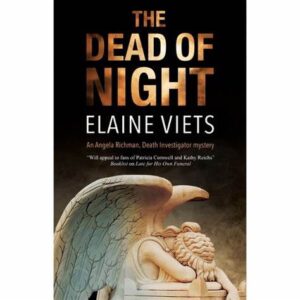
By Elaine Viets
Does the novel you’re writing have a long dream sequence? And it’s in italics, to enhance the ethereal effect? How about sizzling sex scenes? And, for comic relief, a talking cat who solves crimes and a wisecracking kid who’s five going on forty?
Uh, you may want to rethink that work in progress.
Ron Charles, the Washington Post book critic, “asked readers of our Book Club newsletter to describe the things that most annoy them in books. The responses were a tsunami of bile.”
Here are some things that Ron salvaged from the tsunami.
 (1) Readers hate dream sequences.
(1) Readers hate dream sequences.
Yes, I know dream sequences are a staple of literature. In Crime and Punishment, Raskolnikov has guilty dreams, including one about a whipped mare. In Harry Potter and the Order of the Phoenix, the Boy Who Lived is deceived by thoughts implanted by a bad guy. Winston in 1984 worries his dreams will get him in trouble with the Thought Police. A Christmas Carol is a long life-changing dream. And then there’s Shakespeare’s A Midsummer Night’s Dream.
So why should we be wary of dream sequences?
Raging readers told Ron Charles this:
“‘I absolutely hate dream sequences,’ writes Michael Ream. ‘They are always SO LITERAL,’ Jennifer Gaffney adds, ‘usually an example of lazy writing.’”
Aha! So readers hate lazy writing and literal dream sequences. Writing coaches caution writers to avoid cheap tricks, especially the old “and then I woke up” dodge. They say you can use dream sequences if the dreams are premonitions, illustrate an important inner conflict, or help a protagonist realize something major. In short, the dreams must advance the plot. So craft your dream sequences carefully.

(2) Readers hate historical anachronisms and factual inaccuracies.
The Washington Post says, “Karen Viglione Lauterwasser despairs over errors ‘like calling the divisions in a hockey game “quarters” or having a pentagon-shaped table with six chairs.’ Deborah Gravel warns authors that taking a cruise to Alaska is not enough to write a novel about the Last Frontier. Kristi Hart explains that when your characters are boiling maple sap to make syrup, they should not be stirring it. ‘You just boil it until the sugar content is correct, and then you’re done.’”
My pet peeve includes the treatment of black people in historical novels in the first half of the Twentieth Century. With some exceptions, until the late 1950s or 1960s, black people were not allowed to eat in most white restaurants or sit at lunch counters with whites. Nor could they stay at white hotels, go to white schools, use white toilets, or even drink out of white people’s water fountains.
In 1968, I encountered my first segregated water fountain, on a trip through Mississippi. In the local courthouse, the white people drank chilled water from a modern metal fountain. Black people had to drink warm water from a dinky white porcelain fountain. At a Catholic church in the same state, my family arrived late for the service, so we sat in the back. An usher told us that section was for black people (actually, he said “Negroes”) and we had to move.
Encountering this segregation was shocking, but it existed, and to deny it in novels is to deny the shame, hurt and humiliation black people suffered – and still do.
(3) Readers hate typos and grammatical errors.
This is also bugaboo for TKZ readers and writers, and we’ve written often about how to catch typos, while understanding those slippery little devils slip into the best books. But typos seem to be getting worse, especially since traditional publishers are cutting back on copy editors and some indie authors don’t hire them.
The Washington Post noted: “Patricia Tannian, a retired copy editor, writes, ‘It seems that few authors can spell “minuscule” or know the difference between ‘flout’ and ‘flaunt.’ Katherine A. Powers, Book World’s audiobook reviewer, laments that so many ‘authors don’t know the difference between “lie” and “lay.’” TKZ’s Terry Odell wrote a helpful blog on that subject. Read it and sin no more. https://killzoneblog.com/2023/03/are-you-lying-or-laying-around.html
 Personally, I wish writers would know the difference between grizzly and grisly murders. While it’s true the Cocaine Bear and some bears in the wild do kill humans, in most mysteries humans performing those grisly murders.
Personally, I wish writers would know the difference between grizzly and grisly murders. While it’s true the Cocaine Bear and some bears in the wild do kill humans, in most mysteries humans performing those grisly murders.
And please realize that the South American country is spelled Colombia, not Columbia. There’s more, but it’s not a good idea to get me started.
“While we’re at it,” the Washington Post wrote, “let’s avoid ‘bemused.’ Bemused ‘doesn’t mean what you think it means,’ says Paula Willey.”
And please, please learn how to use “chute,” as in where you toss your dirty clothes. I’ve seen major writers call it a “laundry shoot,” which can put holes in clothes.

(4) Readers hate bloated books.
According to the Washington Post, “Jean Murray says, ‘First books by best-selling authors are reasonable in length; then they start believing that every word they write is golden and shouldn’t be cut.’ She notes that Elizabeth George’s first novel, A Great Deliverance, was 432 pages. Her most recent, Something to Hide, is more than 700.
“But it’s not just the books that are too long,” the WashPo says. “Everything in them is too long, too. Readers complained about interminable prologues, introductions, expositions, chapters, explanations, descriptions, paragraphs, sentences, conversations, sex scenes, fistfights and italicized passages.”
(5) Readers hate long italicized passages.
“‘Long passages in italics drive me nuts,’ Susan Spénard told the Washington Post.
“‘Cormac McCarthy does entire chapters in italics,’ adds Nathan Pate. ‘Only the rest of his writing redeems that.’”
(6) Readers hate when writers don’t use quote marks.
“‘Sometimes you have to reread a passage to determine who is speaking,’ one reader said.
Quick now, a few more complaints:
(7) Readers hate “gratuitously confusing timelines.”
“‘Everything doesn’t have to be a linear timeline,’ concedes Kate Stevens, ‘but often authors seem to employ a structure that makes the book unreadable (or at least very difficult to follow). There seems to be no reason why this is done other than to show off how clever they are.’”
(8) Readers hate two kinds of show-offs.

“Unrealistically clever children or talking animals . . . are deeply irksome in novels — along with disabled characters who exist only to provide treacly inspiration.”
Some cozy readers adore talking animals who solve crimes, so this objection doesn’t apply to everyone.
(9) A few more things readers hate, according the Washington Post:
– “Susan C. Falbo is tired of ‘protagonists who have had a hard day, finally stagger home and take a scalding hot shower.’” My protagonists sometimes do that, so I guess the key here is to not overdo it.
 – “Connie Ogle and Susan Dee have had it with ‘lip biting.’ Ogle explains, ‘If real people bit their lips with the frightening regularity of fictional characters, our mouths would be a bloody mess.’
– “Connie Ogle and Susan Dee have had it with ‘lip biting.’ Ogle explains, ‘If real people bit their lips with the frightening regularity of fictional characters, our mouths would be a bloody mess.’
– “Gianna LaMorte is tired of seeing ‘someone escape a small town and rent a large house, get a job at a local paper or make a living gardening.’” The person who flees to a small town and makes a living writing for a newspaper gets my goat. Especially if they have their own office and come and go as they please. Small town newspapers barely pay enough to keep reporters in cat food. And editors want to know where they can reach you at all times.
 And I’m with Tobin Anderson, who wrote, “Vomiting is the new crying. I think it’s part of the whole hyper-valuation of trauma — and somehow tears seem too weak, too mundane. But imagine a funeral filled with upchuckers.” I’m seeing a lot of barfing on TV these days, and watching folks toss their cookies while I’m eating in front of the tube makes me want to . . . well, you get the point.
And I’m with Tobin Anderson, who wrote, “Vomiting is the new crying. I think it’s part of the whole hyper-valuation of trauma — and somehow tears seem too weak, too mundane. But imagine a funeral filled with upchuckers.” I’m seeing a lot of barfing on TV these days, and watching folks toss their cookies while I’m eating in front of the tube makes me want to . . . well, you get the point.
So, TKZ readers, what are your pet peeves?
 Pre-order my new Angela Richman, Death Investigator mystery, The Dead of Night, to be published April 4. https://www.amazon.com/gp/product/1448310350/ref=ox_sc_saved_image_3?smid=ATVPDKIKX0DER&psc=1
Pre-order my new Angela Richman, Death Investigator mystery, The Dead of Night, to be published April 4. https://www.amazon.com/gp/product/1448310350/ref=ox_sc_saved_image_3?smid=ATVPDKIKX0DER&psc=1

That’s a fascinating list of reader peeves, Elaine! I agree with many of them.
My own include novels that open with slam-bang action but no sense of who these battling characters are, and why we should care. Opening with action is okay, but I want some context, even a sentence or three, sprinkled in.
I’m not a fan of prologues because I’ve often found that the second opening AKA chapter 1, starts off with way less narrative interest than the prologue. Certainly prologues can work, and do in some books, but they are tricky, for me at least as a reader.
Prologues are tricky, Dale. When I’ve tried them, my editor had me turn the prologue into Chapter 1. It worked much better.
I think there must be a law that “turned on his/her/their heel” must be in every book. It’s annoying. I always want to add “and broke his/her/their neck”.
Just turn.
Where else are they going to turn, Cynthia?
Generally one turns on the ball of the foot, not the heel.
My pet peeve is for writers and editors who confuse “discrete” and “discreet.” I don’t mind talking animals so much–they’re a staple of some genres. In fact, I’d guess most peeves are a matter of taste rather than rules to follow (except that one about bad research. And discrete/discreet, of course!)
Pray for us writers, Ashley, who need help discreetly.
I just like them to turn without extraneous play by play.
Yep. We can assume it’s a full body turn.
I’d agree with most of the items on the WashPost list, especially the lie/lay bit. I see it all too often in the books I read, though rarely in those by British writers. Odd.
I also agree with Dale’s dislike of prologues. When the first chapter starts with “two weeks/months earlier…” I’m likely to put the book down and never go back to it.
My own pet peeve is undue repetition of character quirks or mannerisms. I read one book recently where the heroine’s heels always clacked when she walked across the tiled floor. It occurred in every chapter she appeared in and sometimes twice, if she walked one way and then returned. A good editor/proofreader should have caught that.
Yep, but good editors are hard to find, Lynda. And they are so overburdened.
I am completely with you. If you have to start your book with action and then jump back in time to start your story, you are admitting that there is nothing interesting in the first half of your book. So why should I care?
Good point, Mark. And sometimes the rest of the book never lives up to that action-packed prologue.
❦ I’m guilty (?) of including a 500 word dream sequence in Mouth of the Lion. It’s a richly deserved and thematic nightmare, and I segue into it with:
❧ Hitler lay awake in the dimly lit room for a long time that night; how long he wasn’t sure, hovering between wakefulness and dozing. He turned over several times before finding a comfortable position. A little later, he heard whispering…
❦ He’s asleep at this point. Italics are used only for internal thought in the sequence, which gradually changes, evoking increasing terror in the MC.
❦ Like much of the book, the scene is based on facts: Hitler, did, indeed, have nightmares, along with night terrors. He liked a trusted SS man to stand watch while he slept. The bloody skeleton in the dream is Geli Raubal’s, whom Hitler murdered.
❦ The bloody, thematic dream becomes the vital motivation to seek therapy from Carl Jung, who is summoned from Zurich and coerced by Gen. Olbricht into treating the reluctant Hitler for the sum of one Marc*.
* Marcus Rosenberg, a fictitious colleague.
❦ Re pet peeves in prose & poetry:
❦ A certain author’s failure to include sufficient dialogue tags to ascertain who is speaking, especially if they’re speaking Spanish, without benefit of quote marks or translations.
❦ The Goldfinch is a pretty good book, but could (and should) have been 20% shorter.
❦ Prize-winning novels that contain a double-negative that means the exact opposite of what the author intended.
❦ Purple prose and twee poetry. Most internerd poetry sucks like a fruit bat on a too-ripe mango. Especially the haiku. Seventeen syllables do not a haiku make. There’s a lot more to it than that.
❦ A Confederacy of Dunces is the worst book I ever DNF’d after two pages. The author ridiculed his own creation mercilessly. I was appalled at this literary equivalent of a face-tattoo.
❦ Another goat-getter is, for example, a SciFi novel where fantasy elements show up about Page 200–elves and spells and such. Respect your genre or don’t write it.
❦ Propaganda of any sort, unless done very cleverly and subtly. A friend’s dad was one of the Hollywood Ten. IMHO, the dad’s plays could be performed today. His parenting skills were non-existent, however, his empathy evidently being reserved for the proletariat.
Another goat-getter is, for example, a SciFi novel where fantasy elements show up about Page 200–elves and spells and such. Respect your genre or don’t write it. – Nailed it.
Love that phrase ‘goat-getter,’ Alan.
Yes, yes to all of these. And I couldn’t read “A Confederacy of Dunces” either. I’m sorry the author is dead, but the book was awful.
But if your dream sequence worked, then I suspect it was okay. I’ve had a dream sequence or two in my books, usually when my character is wrestling with a dilemma.
The only dream that worked in a novel was when Rosemary, before she had THAT BABY, dreamed she was being raped — but she realized it was NOT a dream. That was a clever play on that tired trope, “But it was all a dream …”
Yes, it was. And it produced an amazing. book.
Thanks for the Lie/Lay shout out.
I saw this pet peeve article, too, Elaine (and there goes my next post! 🙂 )
Not all readers are bothered by all these complaints, and as writers, we’ll never please everyone, but it’s good to avoid some of these peeves, especially those that are actual errors. My goof was discrete/discreet which a reader pointed out. Thank goodness for being able to reupload books, even for one mistake. (And no, my editor hadn’t caught it.)
For me, poorly handled POV yanks me out of the story every time, especially self-description that no character would be thinking about.
“… self-description that no character would be thinking about.”
“His reflection in the Hispano-Suiza’s bumper reminded Gerrold that his nose was too large.”
That’s my laugh for the day.
Abrupt POV changes pull me out of book, too, Terry.
I mean “a book.” All readers hate typos.
Interesting. I just want to evaluate each book on its own merit. I don’t hate dream sequences in books, but I have to evaluate them on a per book basis (same with prologues). What works beautifully in one may be poorly handled in another. I have not to date used a dream sequence in one of my stories, but I wouldn’t hesitate to do so if the story called for it.
I believe most would agree that historical inaccuracies, typos and long sections of italics can get tedious.
The one that stumps me is disliking long books. Again, I evaluate on merit of the individual book. If it’s long because it’s poorly written and edited, I get the complaint. If it’s an excellent book that just happens to be long, then so what?
You bring up some good points, BK. Books should be evaluated on their merits. The Harry Potter books are long, but I loved them. However, I find JK Rowling’s adult mysteries a bit too long.
I don’t like it when writers try to impress me with their technical writing skills. The stories feel over-worked and unnatural. I also don’t like pages and pages of description, which is why I would rather watch Lord of the Rings than read it.
One movie can be worth a thousand words, Michelle.
I stopped reading Fellowship of the Rings when we were getting descriptions of every tree they were passing – and they were in a forest.
Good one, Mark!
Elaine, thanks for the checklist of peeves which is handy as I edit my WIP.
Yup, got a couple of short dreams but they are integral to the plot.
A critique buddy just busted me for “too much mouth action” (she wasn’t referring to kissing)–lip biting, lips pressed together, mouthing tightening, etc. Maybe I overdid that b/c for many masked months, people couldn’t see each other’s mouths.
Word misusage bugs me. Reading a book right now with a new word:”flaut”. Must be a blend of “flout” and “flaunt”.
Masking changed everything in the plague year, Debbie. Maybe it’s time to concentrate on eyes.
As long as you don’t roll them!!
Or slide them. I read a best selling author who said, “His eyes slid down her chest.” Ick.
A “flaut” must be the instrument a flautist plays, not so?
Are you fiddling around, JGuenther?
Thanks for the list and tips, Elaine. Good things to watch for.
My biggest peeve is repeated, long sections of dialogue without speaker attributions. If I have to go back and count every other speaker, it pulls me out of the story. This is one place (IMHO) where too much is better than too little.
I’m with you, Steve. And I’ve counted back on dialogue tags more than once to find who is talking.
This is a great list.
I agree with BK that I evaluate books on their own merit, but I find most of these peeves valid. Dream sequences always seemed dumb to write for me. The only time I wrote one was to bring up a painful memory, and I made sure to point out what actually happened vs what was in the dream.
My biggest pet peeve is when you’re expected to like a character just for their minority label or some other unfounded reason, doesn’t matter if they’re protags or secondary characters. I recently read a book where the protagonist was extremely angry and rude and I was supposed to feel sympathy for her just because she had a hard life. Another book I tried to read a while back expected me to like a secondary character just because he looked pretty and was a sex slave but he did nothing to help the protagonist.
Agreed, Azali. Many people who have had hard lives triumph over their past and become empathetic.
The only things that consistently bug me are grammatical errors and typos. Other than those, I agree with BK: I evaluate each book on its own merits. It’s the story I’m interested in.
I recently read a book where all the flashbacks were in italics. I liked it. It gave a dreamy quality to the chapters and reminded me where I was in the story simply by the font. I have a couple of flashback chapters in my WIP, and I’m considering doing them in italics. (Maybe I should put a warning label on the book cover. 🙂 )
LOL, Kay. I agreed with most of the list, but dream sequences can produce classics. If done right.
Many of the “crimes” are in literary fiction, not popular genre, not that we don’t commit the crimes on occasion. On the bloated text, traditional publishers with their overworked editors who don’t have time to edit are as much to blame as the writers who don’t think their writing diarrhea stinks.
As to my own dislikes, a good chunk of my writing advice articles are about disastrous early chapters of books I’ve read. Monday’s was about second books in series where the first chapters clean up events from the first books and tell what the characters have been up to instead of starting the story.
Yes, Marilynn. Reviewers call those second books the sophomore slump. Finish book one — put the conclusions in the last chapter or epilogue, and move on.
I agree with most of this list. Maybe my reading doesn’t have enough dream sequences to bother me.
Word processors and spell check I think are the root of many typos and grammar gaffs. Right is spelled correctly, except I really wanted write. My grammar is far from perfect, if see your errors, you should have paid an editor.
I am a techie with a wide variety of interests. If you are going to name a brand, get the details right. One James Bond continuation book added a back seat in a BMW that left Munich with only two seats.
Bloat – Yes, JRR Tolkien could use two pages to build a bonfire. You aren’t Tolkien. I read one book, by a well known author, with a five page bad psychodelic trip.
“… a five page bad psychedelic trip.”
Autobiographical, perhaps?
But would the author remember it?
Ouch to the James Bond pastiche. Book bloat has become a sign of prestige.
I think the key with many of these is to consider if it is helping the plot or not. Many times, these things can work well, but they are too often used poorly.
For me, my biggest pet peeve is the line “I let out a breath I didn’t know I was holding.” Breathing is unconscious. You have to be thinking about it to hold your breath. I can get holding your breath in a tense situation, especially if you are hiding from someone. But you won’t do it unconsciously. But I’ve read so many books there the author did that. Fortunately, it seems to have slowed down.
Thanks for that reminder, Mark.
I’ll add one more peeve, and this may just be me, but I can’t stand male characters that don’t act or think like males. There are a few women writers who get it right, our Terry Odell being one, but I’ve put down many romantic suspense and even thrillers because the men were unrealistic.
Reminds me of the Youtube video I saw of a dad complaining about his daughter pestering him with questions about how nice her eyebrows looked. He finally told her, “If a woman walks into a bar, the last thing men look at is her eyebrows.” Well said. 🙂
One other pet peeve. Too much internalization during a life-threatening situation.
Yes, action scenes must be terse, with minimal detail–sumi-e, not pointillism. One beginning thud-and-blunder author armed his MC with a crutch that could be converted into a sort of bludgeon. The writer attempted to cover the fact that anyone pausing during a fight to disassemble a crutch would likely be dead before he could reassemble it, by stating: “With incredible speed, Jones converted his crutch into a deadly tong fa.” Incredible, indeed.
Another good comment. Maybe the MC should have had a sword cane.
Good grief! Rolling my eyes.
Thanks so much for the mention, CMP. I remember having the Hubster read my first male POV scene, and his first comment was “Give him a bigger truck.” Then, about 20 minutes later, he comes into my office and says, “You know where she sat on the couch and tucked her legs under her? He’d have looked.” (Yes, she was wearing a skirt.) I ran that by a few other male acquaintance to make sure the Hubster’s reaction wasn’t a one-off, and they all agreed, it was hard wired into the male DNA.
I check details about men with my husband, too, Terry.
Yes!
I also check with my husband when writing male MC scenes. I have the added advantage of his 34 years of law enforcement experience (including S.W.A.T) along with his all-male attitude. It helps!
Thanks for adding these, Cecilia.
Personal pet peeve, which I’ve seen this in a many books I’ve read lately, is 21st century morals in turn of the century (as in 1900) historical novels. Suddenly, the main character is so forward thinking that she isn’t bothered in the least by lifestyles that weren’t even illegal in her time and location. I read for entertainment, not so I can be proselytized, and it makes the book comes across as a pushy agenda from the author. I also dislike a contemporary voice given to a historical character.
Yes, that’s one of mine, too, Mac. Many of the actions that modern women do would have had them ostracized in earlier times.